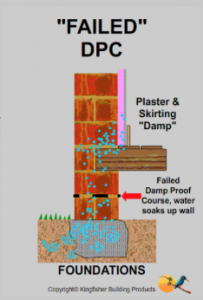
Rising Damp
Rising damp is when moisture is absorbed from the ground into the walls, by capillary action through the pores of the masonry seeking a means of evaporation. All new houses are built with a Damp proof course (DPC) which forms a barrier against the moisture rising. Older houses however may have been built without a DPC or it may have deteriorated over time or changes to the building may have compromised the DPC, i.e. built up patios breaching the DPC. Garage buildings may have been converted without installing a DPC or maybe you are thinking about converting a garage and not sure if you need a DPC? A new chemical DPC can be installed creating a new barrier against moisture raising. Plasterhawks are raising damp experts and can give you a full damp inspection to identify the issue.
Damp Proof Course Installation (DPC)
This is a rough guide to the process, a tailored solution is recommended for all clients
· Client to remove radiator.
· Plasterhawks will remove skirting boards however cannot guarantee they will be suitable for reusing as they may be damaged from the damp in the walls, a carpenter will be able to replace the skirting’s once the wall is dry.
· The contaminated plaster is removed back to brickwork, approx. 300mm above the last visible signs of moisture or 1 meter.
· A new DPC is then installed by our fully trained technicians.
· A waterproof render mix is applied to the walls followed by a final coat of plaster to leave a smooth finish.
All rubbish will be removed from the site and disposed of responsibly.
Damp Proof Course (DPC) Aftercare
Following a DPC installation water-based systems, curing may take a few days to several weeks to dissipate depending on the thickness and environmental conditions prevailing, once the evaporation is complete the DPC should be effective.
In all cases irrespective of the speed of DPC formation, 225mm walls will take at least 12 months to dry out. Water will still be present in the walls and needs time to evaporate. The presence of paint or renders will substantially extend the drying period and hence the time before impervious decorations such as wallpaper or vinyl/eggshell paint can be safely applied.
It is advisable to consider any decoration within the first 12 months to be temporary and only use two fine miss coats of emulsion paint as this will allow the walls to continue to dry out, and only 3 weeks following the completion of the DPC.
The damp proofed walls should not be dried too quickly with excessive heat because this could cause cracking to the render coat.
Are you sure it is Rising damp?
Check out the links below or contact us for more information

